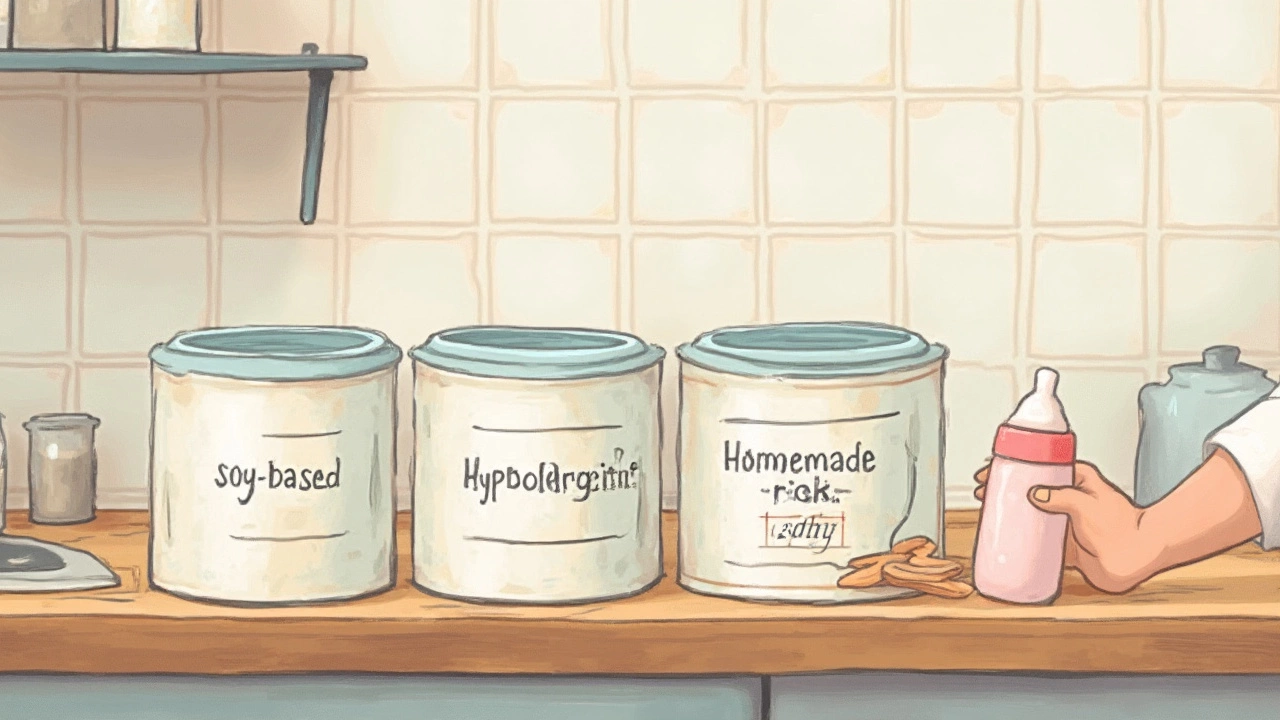What Can I Use Instead of Milk for Baby Formula? Safe Alternatives Explained

If your baby can't drink regular milk formula, it can turn even the calmest parent into a ball of nerves. Maybe your little one has a milk allergy, or you just realized your store's shelves are bare again. It's tough knowing what's safe when you need a backup option that won’t make things worse.
First things first: not all alternatives are created equal. You can't just swap in regular cow’s milk, almond milk, or oat milk and call it a day. Babies have very specific nutritional needs. Giving the wrong substitute can seriously mess with their growth, tummy, or immune system. This is where specially-made formulas step in. They’re designed to give infants everything they need, minus the cow’s milk protein or lactose that might be causing trouble.
Doctors and pediatric dietitians have seen it all, so don’t be shy about asking for their advice. They can help you pick a formula that’s right for your baby—especially if there are allergies in the family, or if your baby’s been fussier than usual after bottles. Keep reading to learn exactly what you can use, why it’s safe, and some tips for navigating those tricky moments when milk just isn’t an option.
- Why Use Milk Alternatives?
- Popular Store-Bought Substitutes
- What About Homemade Formula?
- Recognizing Signs of Formula Issues
- Frequently Asked Questions
Why Use Milk Alternatives?
Sometimes standard milk-based baby formula just doesn't cut it—either because of an allergy, an intolerance, or even personal choices like being vegan. About 2-3% of infants under 3 years old actually have a real cow's milk protein allergy. Some have trouble with lactose, the sugar in milk, causing tummy upsets, rashes, or even breathing problems. In cases like these, switching to baby formula alternatives is more than convenient—it's a must.
Diving a little deeper, here are the big reasons you might need a milk substitute for babies:
- Milk allergy: Signs include vomiting, diarrhea, crying after feeds, skin rashes, hives, and (rarely) more serious reactions like swelling or breathing trouble. A true cow’s milk protein allergy isn’t something your baby will just “get over” while still a baby—you actually need to swap the formula with help from your doctor.
- Lactose intolerance: Different from a milk allergy, but can still cause lots of discomfort. Expect gas, bloating, and diarrhea if your baby can't handle lactose.
- Special diets: Some families need or choose non-dairy formula for religious, ethical, or health reasons. Whatever your reason, safe options exist that still give all the good stuff your baby needs to grow.
- Premature babies or specific health conditions: Certain medical needs might mean special formulas are best (preemie formulas, for instance, or formulas for babies with metabolic issues).
As tempting as it could be to grab soy milk or rice milk off the shelf, most plain plant milks just don't cut it for infants. They don’t have enough protein, fat, vitamins, or minerals for proper growth—especially in the first year. Store-bought hypoallergenic formula and specialty formulas are made to fill these gaps safely.
Keep an eye out for red flags like blood in stool, itchiness, constant reflux, or poor weight gain. These are solid reasons to talk to the pediatrician about infant feeding options beyond regular milk formula. Acting quickly means your little one stays happy, safe, and growing strong.
| Common Reason | Percent of Babies Affected |
|---|---|
| Milk Allergy | 2-3% |
| Temporary Lactose Intolerance | Up to 10% after stomach bug |
| Family Vegan/Religious Diets | Unknown—varies by community |
Popular Store-Bought Substitutes
When cow’s milk formula is off the table, the good news is you’ve got several safe baby formula alternatives right at your local pharmacy or grocery store. Every option is built around what babies actually need: protein, fat, carbs, vitamins, and minerals. Here’s what you’ll see on the shelf—and why you’d reach for one over the other.
- Soy-Based Formula: Hands down, the top choice when you need a milk substitute for babies that’s easy to find and affordable. Soy formulas use soy protein, so there’s no cow’s milk at all. Brands like Similac Soy Isomil and Enfamil ProSobee are everywhere. Doctors often suggest soy if babies react badly to both milk and lactose.
- Hydrolyzed (Hypoallergenic) Formula: If your little one’s allergies are more intense, these options break down proteins into teeny pieces to minimize allergic reactions. Nutramigen and Alimentum are the big names here. They’re expensive, but can be life-changing when you’re desperate for a non-dairy formula.
- Amino Acid-Based Formula: Sometimes even hydrolyzed options aren’t gentle enough. Amino acid formulas (like Neocate or EleCare) are basically hypoallergenic to the max. They’re a lifesaver for severe allergies, but most parents only try these if nothing else works—mainly because they’re pricy and usually need a doctor’s note for insurance coverage.
- Goat Milk-Based Formula: Some parents try this thinking it’s less allergenic, but don’t go there without your doctor’s okay. Goat’s milk isn’t a magic fix—its proteins are pretty similar to cow’s milk, and it’s not safe straight from the carton, either. Only formulas specially processed for babies (like Kabrita) should even be considered.
- Lactose-Free Formula: Not every issue is a milk allergy—sometimes it’s just a problem with lactose, the sugar in milk. Lactose-free formulas (like Enfamil Gentlease) swap out the milk sugar for something easier to handle. Super helpful for babies with gas, bloating, and general tummy trouble who don’t have a true allergy.
Here’s a quick look at how these infant feeding options stack up for key allergy symptoms:
| Formula Type | No Cow's Milk Protein | No Lactose | For Severe Allergies |
|---|---|---|---|
| Soy-Based | ✔️ | ✔️ | ✖️ |
| Hydrolyzed | ✔️ | ✔️ | ✔️ (in most cases) |
| Amino Acid-Based | ✔️ | ✔️ | ✔️ (most severe cases) |
| Goat Milk-Based | ✖️ | ✔️ (varies) | ✖️ |
| Lactose-Free | ✖️ | ✔️ | ✖️ |
Most of these non-dairy formula options come ready-to-feed, in powder, or as a liquid concentrate. Always follow package directions—using the wrong water/formula mix can make a baby sick. When in doubt, your pediatrician is the go-to for a recommendation matched to your baby’s history and symptoms. It takes out the guesswork and the panic.

What About Homemade Formula?
If you’ve thought about whipping up your own baby formula at home, you’re definitely not alone. Scroll through parenting forums, and it pops up all the time—especially when baby formula shortages hit. But here’s the deal: homemade formulas are risky and not recommended by doctors or pediatric groups, including the American Academy of Pediatrics.
Babies need precise amounts of protein, fat, vitamins, and minerals. Home recipes—no matter how many ingredients they list—just can’t match the nutrition found in store-bought baby formula alternatives. These homemade blends often miss key things like iron, which helps with brain growth, or the right type of fat for healthy eyes and nerve development. Getting it wrong can cause low blood levels, seizures, or even heart problems.
Let’s look at some common issues with homemade formula:
- Unsafe ingredients: Some recipes use raw milk, which isn’t safe for babies due to bacteria and contaminants.
- Wrong nutrition: Even with good intentions, recipes may have too much salt, not enough vitamins, or missing fatty acids critical for growth.
- No FDA safety checks: Store-bought infant feeding options have to meet strict standards. Homemade formulas don’t.
- Inconsistent results: Making the same recipe day after day can still give you different nutrition every batch. That’s risky for infants with tiny bodies and big needs.
If you’re struggling to buy formula, try reaching out to your pediatrician, local food banks, or WIC offices. There are swap programs, milk banks, and even formula samples available in a pinch. But doctors agree: don’t mess with homemade formula. Your baby’s health just isn’t worth the gamble.
Recognizing Signs of Formula Issues
Switching to a baby formula alternative can sometimes stir up new problems, especially if your baby’s system doesn’t agree with the change. Babies aren’t shy about showing you when something's off, but the signs aren’t always what you’d expect. Knowing what to look out for helps you get ahead of bigger problems before they start.
The most common red flags to watch for after trying a new milk substitute for babies include:
- Frequent spit-up or vomiting: If your baby is spitting up way more than usual or throws up with almost every feeding, don’t brush it off.
- Diarrhea or weird-looking poop: Watery, green, or bloody stools could mean your baby’s gut isn’t handling the current formula well.
- Rashes around the mouth, bottom, or elsewhere: Red, bumpy skin can be a sign of a formula allergy, especially with cow’s milk protein.
- Excess fussiness, crying, or obvious tummy pain: Babies with bad reactions often get gassy, scrunch up their legs, or act more irritable than normal.
- Breathing issues or swelling: Trouble breathing, swelling of the lips or eyes, or wheezing after a bottle can be a sign of a serious allergy. Call for emergency help if this happens.
- Poor weight gain: If your baby isn’t growing as expected, it could be a clue the formula isn’t providing what they need, or their body isn’t absorbing it well.
Here’s a quick table doctors use to compare common formula issues:
| Sign | Possible Cause |
|---|---|
| Excess spit-up | Reflux, intolerance |
| Constipation | Iron content, formula change |
| Rash or eczema | Milk allergy, soy allergy |
| Bloody stools | Severe allergy |
It’s tempting to keep switching around non-dairy formula options if your baby seems uncomfortable, but rapid changes can make things worse. Always track symptoms, write down what you notice, and bring that info to your pediatrician. If something feels really off—like trouble breathing, nonstop vomiting, or blood in the diaper—get medical help right away.
Remember, there’s no one-size-fits-all formula. Keeping an eye on these signs helps you and your doctor find the safest, most comfortable infant feeding option for your little one. You know your baby best, so trust your gut if things don’t seem right.

Frequently Asked Questions
Let’s clear up some of the biggest questions parents ask about baby formula alternatives and milk substitutes for babies.
- Can I give my baby regular plant milks like almond, soy, or oat?
Coffee shops might love them, but these milks just don’t cut it for babies. They lack key nutrients like protein, fat, calcium, and vitamins babies need for their bodies and brains. Even unsweetened, they’re risky. Only use plant-based formulas made just for infants. - Is goat’s milk a safe alternative to cow’s milk for babies?
Goat milk isn’t recommended for babies under 12 months, even in a pinch. It’s short on the right balance of vitamins, especially folic acid, and can lead to serious nutritional gaps. Some European formulas use goat milk protein, but these are specially modified for infants—big difference from plain goat milk you find at the store. - What are “hypoallergenic” formulas, and who are they for?
These formulas break down milk proteins so tiny, babies with allergies or severe sensitivities usually do fine on them. If your child has eczema or a diagnosed milk protein allergy, these are a go-to. Most are labeled as "extensively hydrolyzed" or "amino acid-based." These are scientifically shown to reduce allergic reactions. - How do I know if my baby needs a non-dairy formula?
Common signs: extra gassiness, skin rashes, vomiting, or blood-streaked poop after feeding. If a parent or sibling has food allergies, your pediatrician might suggest starting on a hypoallergenic or non-dairy formula just to play it safe. Never guess—always talk with your child’s doctor before switching. - Is it okay to mix and match different formulas?
Switching between formulas sometimes happens if your store is out, but regular switching can upset your baby’s tummy. If you need to transition, do it slowly, mixing a little more of the new formula each day. Ask your pediatrician for a plan that fits your situation. - Are store brands just as good as name brands?
Absolutely. The FDA checks all infant formula—fancy packaging doesn’t mean extra nutrition. Generic brands are nutritionally complete and safe, which is good news when you’re budgeting for diapers, too. - Can I make my own formula at home?
It might sound resourceful, but homemade formulas are not safe. Babies can end up lacking nutrients—or get too much of something that can cause serious harm. Store-bought baby formula alternatives really are the only reliable option if you can’t breastfeed.
If you’re curious about cost or what other parents are using, here’s a quick look at how different formula types compare:
| Formula Type | Average Cost per Month (USD) | Best For |
|---|---|---|
| Cow’s Milk-Based Standard Formula | $100 - $150 | Most healthy infants |
| Soy-Based Formula | $125 - $175 | Milk allergy, lactose intolerance, vegan families |
| Hypoallergenic Formula | $250 - $400 | Severe allergies or protein intolerance |
The bottom line? Always talk with a healthcare provider before trying a new infant feeding option. Feeding your baby is stressful enough—make sure you’re getting real answers, not a Google rabbit hole of myths and bad ideas.

